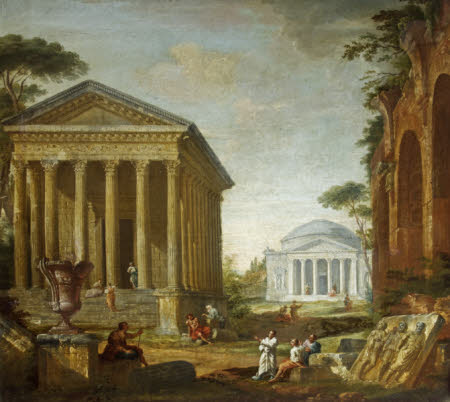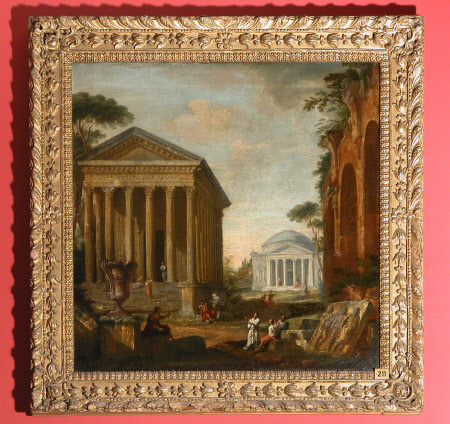Architectural Capriccio with the Pantheon and the Maison Carrée (manner of Panini)
attributed to Francis Harding (fl. c.1730 – 1760)
Category
Art / Oil paintings
Date
circa 1745
Materials
Oil on canvas
Measurements
724 x 470 mm (28½ x 18½ in)
Place of origin
England
Order this imageCollection
Stourhead, Wiltshire
NT 732275
Summary
Oil painting on canvas, Architectural Capriccio with the Pantheon and the Maison Carrée attributed to Francis Harding (fl. c.1730 – 1760) in the manner of Giovanni Paolo Panini (Piacenza 1691-Rome 1765), circa 1745.
Full description
This picture is composed of a number of elements taken from Panini's Capriccios of antique architecture, together with a few inventions of the artist's own. The left-hand side is based on a signed and dated Capriccio of Panini's of 1745, formerly in the Palkse collection (Arisi, 1986, cat. no.358), but with two different figures on the steps of the Maison Carrée, and the vase changed to a form found in other Paninis (e.g. Arisi, cat. nos.363 & 364). The ruined structure on the right occurs in the same place in a picture in the Royal Collection (Arisi, cat. no.311; copy, cat. no.328; M. Levey, The Later Italian Pictures in the Collection of her Majesty the Queen, no.559, p.90 and pl.181), on which a date read as 1735 has now been found. The form given to the Pantheon appears, however, to be of the artist's own invention, as does the relief on the right, authentically Paninian Antique though it seems. This borrowing from so many Paninian sources, combined with the ability to invent in the latter's own idiom, leads to the almost ineluctable conclusion that the artist had worked in Panini's studio (if he is indeed Francis Harding, this would presuppose a version of the Palkse picture earlier than 1745, since by that year he was back in England, so as to paint the burnt-out St John's Smith Square before it was rebuilt [cf. Hilda Finberg, Country Life, 1 May 1920, pp.596-97], and to receive a payment from Henry Hoare that year). Since Harding appears to have passed through Provence on his way to or from Rome and to have drawn its “antiques” at St Remy/Glanum, of which he was to make such repeated use here at Stourhead and elsewhere (cf. card for his Sacrifice of Iphigenia), there is an intriguing possibility that it was through drawings of his own, rather than through engravings, that Panini acquired his knowledge of the appearance of the Maison Carrée at Nîmes. He seems first to have employed this in a Capriccio painted for and/or formerly in the collection of the Duke of Norfolk dated 1735 (perhaps significantly, 1735 is also the date that has been found on one of the Paninis from which a detail of the present picture appears to derive; now John Herron Art Museum, Indianopolis; Arisi, cat. no.232); followed shortly after by one of the Capriccios painted for Marble Hill in 1738 (Arisi, cat. no.254), and another dated 1738 acquired by the Earl of Harcourt in 1742 (Arisi, cat. no.267). The coincidence that all of these pictures were in - and may even have been painted directly for - English collections, raises the further possibility that Harding may have served as an intermediary between Panini and his English clients, amongst whom these would appear to have been the very earliest after Henry Grey, Duke of Kent, who had commissioned a variant of the View of the Nave of St Peter's, originally commissioned by Cardinal Polignac in 1730, in 1734 (Arisi, cat. nos. 200 and 217). But if Harding did supply Panini with a drawing of the Maison Carrée he perhaps only drew the Mausoleum at St Remy/Glanum on his way home, since this never occurs in Panini's authentic works. There is a compositionally similar painting, also with the Maison Carrée as its main motif, and likewise serving as an overmantel, in the Green Drawing Room at Clandon. Certain of the figures are almost identical, but both the subsidiary buildings and the sculpture are different. Unless it is simply a straight copy by another hand of the Panini from which Harding took the elements for the present picture, the temptation to attribute it too to Harding is irresistible. Alastair Laing, Curator of Pictures and Sculpture
Provenance
Brought from Wavendon by Sir Henry Hugh Arthur Hoare 6th Bt (1865 - 1947) and Alda Weston, Lady Hoare (d. 1947) between 1894 and 1898; given to the National Trust along with the house, its grounds, and the rest of contents by Sir Henry Hugh Arthur Hoare, 6th Bt (1865 – 1947) in 1946
Credit line
Stourhead, The Hoare Collection (National Trust)
Makers and roles
attributed to Francis Harding (fl. c.1730 – 1760), artist manner of Giovanni Paolo Panini (Piacanza c.1692 - Rome 1765) , artist

